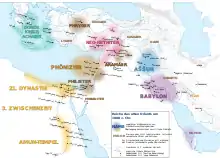Middle Babylonian period
The Middle Babylonian[1] or Post-Kassite period[1] was the period in Babylonian history that followed the collapse of the Kassite dynasty c. 1150 BC and preceded the conquest of Babylonia by the Neo-Assyrian Empire in 729 BC.[1] On account of political turmoil and the textual record falling silent, relatively little is known of events in Babylonia during this time.[2]

There exists various alternate definitions of the Middle Babylonian period. On account of Assyrian control of Babylonia being unstable, and the continued similarities in material culture, some historians designate the Middle Babylonian period as not ending until 626 BC, with the collapse of the Neo-Assyrian Empire and the establishment of the Neo-Babylonian Empire.[1] Some use "Middle Babylonian" and "post-Kassite" as names for distinct periods, with the Middle Babylonian period containing the Kassite dynasty, and sometimes the later Second Dynasty of Isin, and following dynasties being grouped under the "post-Kassite" period.[2][3] Others designate the entire period between the fall of the Old Babylonian Empire in 1595 BC and the rise of Neo-Babylonian Empire as "Middle Babylonian".[4]
References
- Baker 2012, p. 914.
- Knott 2000.
- Slanski 2003, p. 485.
- Finegan 1979, p. 73.
Bibliography
- Baker, Heather D. (2012). "The Neo-Babylonian Empire". In Potts, D. T. (ed.). A Companion to the Archaeology of the Ancient Near East: Volume I. John Wiley & Sons Ltd. ISBN 978-1444360790.
- Finegan, Jack (1979). Archaeological History of the Ancient Middle East. New York: Routledge. ISBN 978-0429047404.
- Slanski, Kathryn (2003). "Mesopotamia: Middle Babylonian Period". In Westbrook, Raymond (ed.). A History of Ancient Near Eastern Law. Brill Publishers. ISBN 978-9047402091.
Web sites
- Knott, Elizabeth (2000). "The Middle Babylonian / Kassite Period (ca. 1595–1155 B.C.) in Mesopotamia". The Metropolitan Museum of Art. Retrieved 23 January 2021.